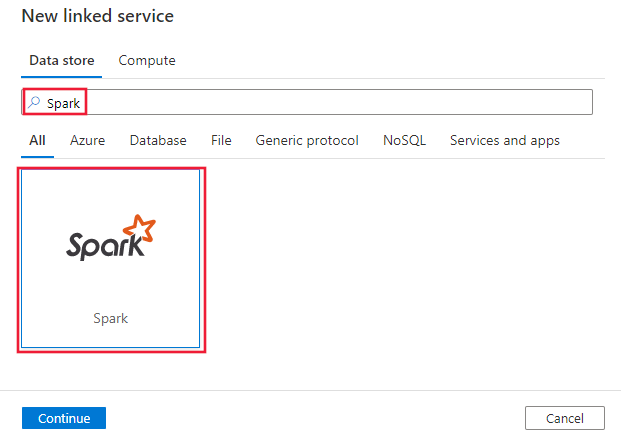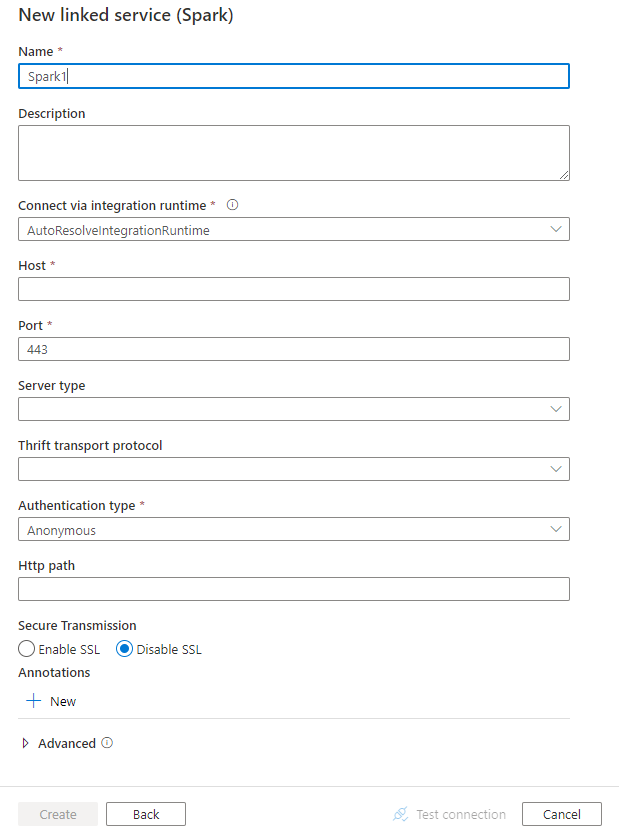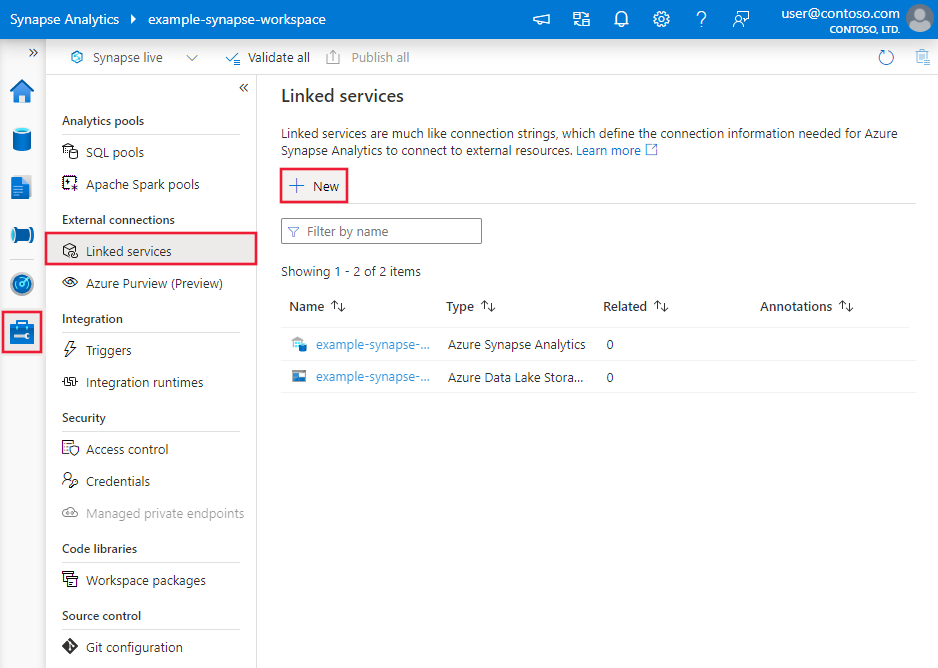Note
Access to this page requires authorization. You can try signing in or changing directories.
Access to this page requires authorization. You can try changing directories.
APPLIES TO:  Azure Data Factory
Azure Data Factory  Azure Synapse Analytics
Azure Synapse Analytics
This article outlines how to use the Copy Activity in an Azure Data Factory or Synapse Analytics pipeline to copy data from Spark. It builds on the copy activity overview article that presents a general overview of copy activity.
This Spark connector is supported for the following capabilities:
| Supported capabilities | IR |
|---|---|
| Copy activity (source/-) | ① ② |
| Lookup activity | ① ② |
① Azure integration runtime ② Self-hosted integration runtime
For a list of data stores that are supported as sources/sinks by the copy activity, see the Supported data stores table.
The service provides a built-in driver to enable connectivity, therefore you don't need to manually install any driver using this connector.
If your data store is located inside an on-premises network, an Azure virtual network, or Amazon Virtual Private Cloud, you need to configure a self-hosted integration runtime to connect to it.
If your data store is a managed cloud data service, you can use the Azure Integration Runtime. If the access is restricted to IPs that are approved in the firewall rules, you can add Azure Integration Runtime IPs to the allow list.
You can also use the managed virtual network integration runtime feature in Azure Data Factory to access the on-premises network without installing and configuring a self-hosted integration runtime.
For more information about the network security mechanisms and options supported by Data Factory, see Data access strategies.
To perform the Copy activity with a pipeline, you can use one of the following tools or SDKs:
- The Copy Data tool
- The Azure portal
- The .NET SDK
- The Python SDK
- Azure PowerShell
- The REST API
- The Azure Resource Manager template
Use the following steps to create a linked service to Spark in the Azure portal UI.
Browse to the Manage tab in your Azure Data Factory or Synapse workspace and select Linked Services, then click New:
Search for Spark and select the Spark connector.

Configure the service details, test the connection, and create the new linked service.

The following sections provide details about properties that are used to define Data Factory entities specific to Spark connector.
The Spark connector now supports version 2.0 (Preview). Refer to this section to upgrade your Spark connector version from version 1.0. For the property details, see the corresponding sections.
The following properties are supported for Spark linked service version 2.0 (Preview):
| Property | Description | Required |
|---|---|---|
| type | The type property must be set to: Spark | Yes |
| version | The version that you specify. The value is 2.0. |
Yes |
| host | IP address or host name of the Spark server | Yes |
| port | The TCP port that the Spark server uses to listen for client connections. If you connect to Azure HDInsights, specify port as 443. | Yes |
| serverType | The type of Spark server. The allowed value is: SparkThriftServer |
No |
| thriftTransportProtocol | The transport protocol to use in the Thrift layer. The allowed value is: HTTP |
No |
| authenticationType | The authentication method used to access the Spark server. Allowed values are: Anonymous, UsernameAndPassword, WindowsAzureHDInsightService |
Yes |
| username | The user name that you use to access Spark Server. | No |
| password | The password corresponding to the user. Mark this field as a SecureString to store it securely, or reference a secret stored in Azure Key Vault. | No |
| httpPath | The partial URL corresponding to the Spark server. | No |
| enableSsl | Specifies whether the connections to the server are encrypted using TLS. The default value is true. | No |
| connectVia | The Integration Runtime to be used to connect to the data store. Learn more from Prerequisites section. If not specified, it uses the default Azure Integration Runtime. | No |
Example:
{
"name": "SparkLinkedService",
"properties": {
"type": "Spark",
"version": "2.0",
"typeProperties": {
"host": "<cluster>.azurehdinsight.cn",
"port": "<port>",
"authenticationType": "WindowsAzureHDInsightService",
"username": "<username>",
"password": {
"type": "SecureString",
"value": "<password>"
}
}
}
}
The following properties are supported for Spark linked service version 1.0:
| Property | Description | Required |
|---|---|---|
| type | The type property must be set to: Spark | Yes |
| host | IP address or host name of the Spark server | Yes |
| port | The TCP port that the Spark server uses to listen for client connections. If you connect to Azure HDInsights, specify port as 443. | Yes |
| serverType | The type of Spark server. Allowed values are: SharkServer, SharkServer2, SparkThriftServer |
No |
| thriftTransportProtocol | The transport protocol to use in the Thrift layer. Allowed values are: Binary, SASL, HTTP |
No |
| authenticationType | The authentication method used to access the Spark server. Allowed values are: Anonymous, Username, UsernameAndPassword, WindowsAzureHDInsightService |
Yes |
| username | The user name that you use to access Spark Server. | No |
| password | The password corresponding to the user. Mark this field as a SecureString to store it securely, or reference a secret stored in Azure Key Vault. | No |
| httpPath | The partial URL corresponding to the Spark server. | No |
| enableSsl | Specifies whether the connections to the server are encrypted using TLS. The default value is false. | No |
| trustedCertPath | The full path of the .pem file containing trusted CA certificates for verifying the server when connecting over TLS. This property can only be set when using TLS on self-hosted IR. The default value is the cacerts.pem file installed with the IR. | No |
| useSystemTrustStore | Specifies whether to use a CA certificate from the system trust store or from a specified PEM file. The default value is false. | No |
| allowHostNameCNMismatch | Specifies whether to require a CA-issued TLS/SSL certificate name to match the host name of the server when connecting over TLS. The default value is false. | No |
| allowSelfSignedServerCert | Specifies whether to allow self-signed certificates from the server. The default value is false. | No |
| connectVia | The Integration Runtime to be used to connect to the data store. Learn more from Prerequisites section. If not specified, it uses the default Azure Integration Runtime. | No |
Example:
{
"name": "SparkLinkedService",
"properties": {
"type": "Spark",
"typeProperties": {
"host" : "<cluster>.azurehdinsight.cn",
"port": "<port>",
"authenticationType": "WindowsAzureHDInsightService",
"username": "<username>",
"password": {
"type": "SecureString",
"value": "<password>"
}
}
}
}
For a full list of sections and properties available for defining datasets, see the datasets article. This section provides a list of properties supported by Spark dataset.
To copy data from Spark, set the type property of the dataset to SparkObject. The following properties are supported:
| Property | Description | Required |
|---|---|---|
| type | The type property of the dataset must be set to: SparkObject | Yes |
| schema | Name of the schema. | No (if "query" in activity source is specified) |
| table | Name of the table. | No (if "query" in activity source is specified) |
| tableName | Name of the table with schema. This property is supported for backward compatibility. Use schema and table for new workload. |
No (if "query" in activity source is specified) |
Example
{
"name": "SparkDataset",
"properties": {
"type": "SparkObject",
"typeProperties": {},
"schema": [],
"linkedServiceName": {
"referenceName": "<Spark linked service name>",
"type": "LinkedServiceReference"
}
}
}
For a full list of sections and properties available for defining activities, see the Pipelines article. This section provides a list of properties supported by Spark source.
To copy data from Spark, set the source type in the copy activity to SparkSource. The following properties are supported in the copy activity source section:
| Property | Description | Required |
|---|---|---|
| type | The type property of the copy activity source must be set to: SparkSource | Yes |
| query | Use the custom SQL query to read data. For example: "SELECT * FROM MyTable". |
No (if "tableName" in dataset is specified) |
Example:
"activities":[
{
"name": "CopyFromSpark",
"type": "Copy",
"inputs": [
{
"referenceName": "<Spark input dataset name>",
"type": "DatasetReference"
}
],
"outputs": [
{
"referenceName": "<output dataset name>",
"type": "DatasetReference"
}
],
"typeProperties": {
"source": {
"type": "SparkSource",
"query": "SELECT * FROM MyTable"
},
"sink": {
"type": "<sink type>"
}
}
}
]
When you copy data from and to Spark, the following interim data type mappings are used within the service. To learn about how the copy activity maps the source schema and data type to the sink, see Schema and data type mappings.
| Spark data type | Interim service data type (for version 2.0 (Preview)) | Interim service data type (for version 1.0) |
|---|---|---|
| BooleanType� | Boolean� | Boolean� |
| ByteType� | Sbyte� | Int16� |
| ShortType� | Int16� | Int16� |
| IntegerType� | Int32� | Int32� |
| LongType� | Int64� | Int64� |
| FloatType� | Single� | Single� |
| DoubleType� | Double� | Double� |
| DateType� | DateTime� | DateTime� |
| TimestampType� | DateTimeOffset� | DateTime� |
| StringType� | String� | String� |
| BinaryType� | Byte[]� | Byte[]� |
| DecimalType� | Decimal� | Decimal� |
| ArrayType� | String� | String� |
| StructType� | String� | String� |
| MapType� | String� | String� |
| TimestampNTZType� | DateTime� | DateTime� |
| YearMonthIntervalType� | String� | Not supported.� |
| DayTimeIntervalType� | String� | Not supported. |
To learn details about the properties, check Lookup activity.
In�Edit linked service�page, select�2.0�for version and configure the linked service by referring to�Linked service properties version 2.0 (Preview).
The data type mapping for the Spark linked service version 2.0 (Preview) is different from that for the version 1.0. To learn the latest data type mapping, see�Data type mapping for Spark.
The Spark connector version 2.0 (Preview) offers new functionalities and is compatible with most features of version 1.0. The following table shows the feature differences between version 2.0 (Preview) and version 1.0.
| Version 2.0 (Preview)� | Version 1.0� |
|---|---|
SharkServer and SharkServer2 are not supported for serverType. |
Support SharkServer and SharkServer2 for serverType. |
Binary and SASL are not supported for thriftTransportProtocl. |
Support Binary and SASL for thriftTransportProtocl. |
| Username authentication type is not supported. | Support Username authentication type. |
The default value of enableSSL is true. trustedCertPath, useSystemTrustStore, allowHostNameCNMismatch and allowSelfSignedServerCert are not supported. |
The default value of enableSSL is false. Additionally, support trustedCertPath, useSystemTrustStore, allowHostNameCNMismatch and allowSelfSignedServerCert. |
| The following mappings are used from Spark data types to interim service data types used by the service internally. TimestampType -> DateTimeOffset YearMonthIntervalType -> String DayTimeIntervalType -> String |
The following mappings are used from Spark data types to interim service data types used by the service internally. TimestampType -> DateTime Other mappings supported by version 2.0 (Preview) listed left are not supported by version 1.0. |
For a list of data stores supported as sources and sinks by the copy activity, see supported data stores.

